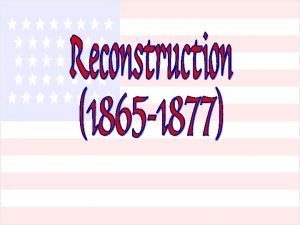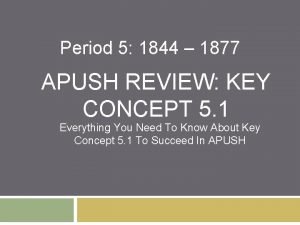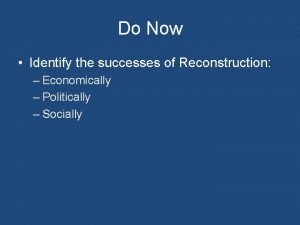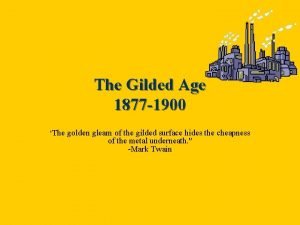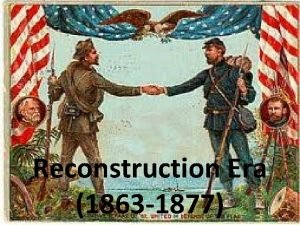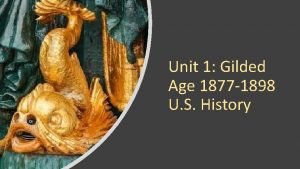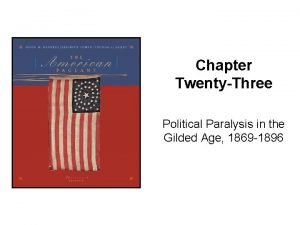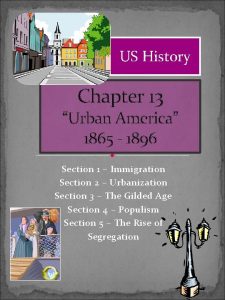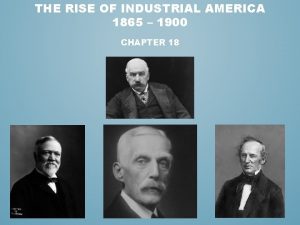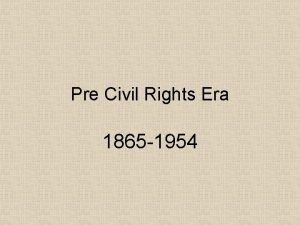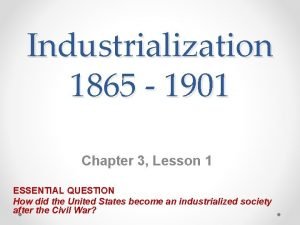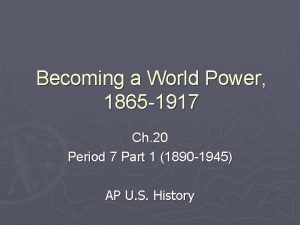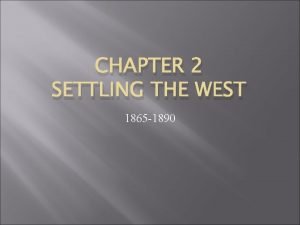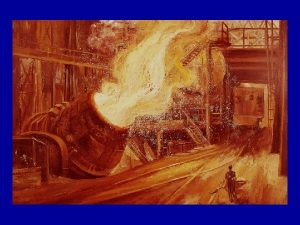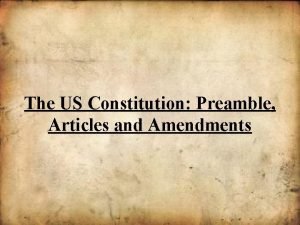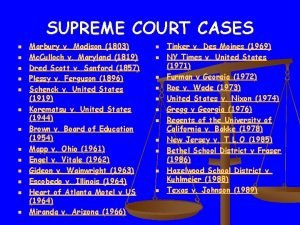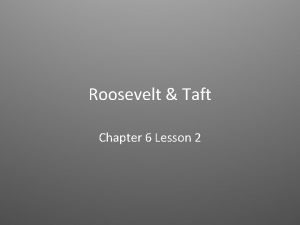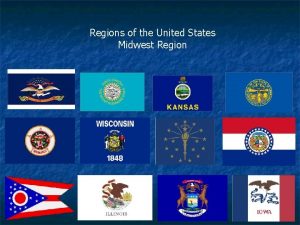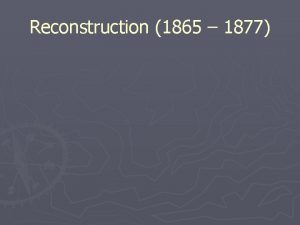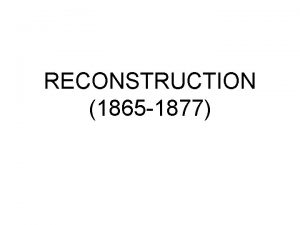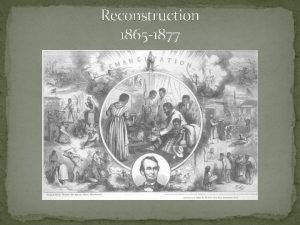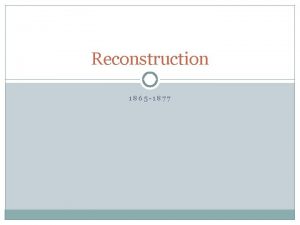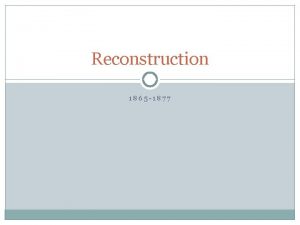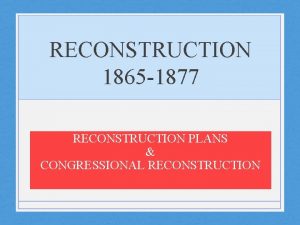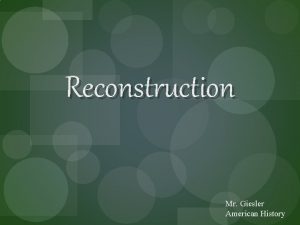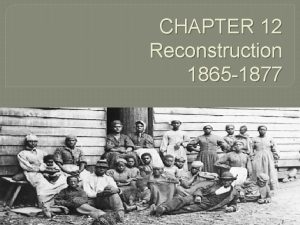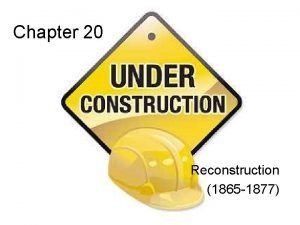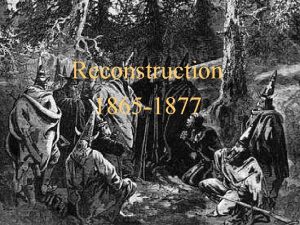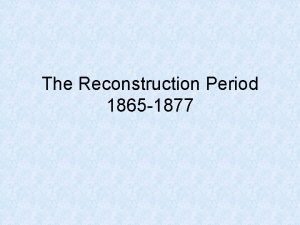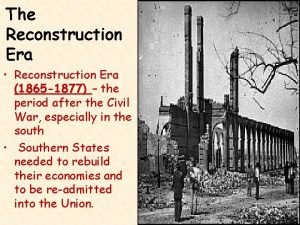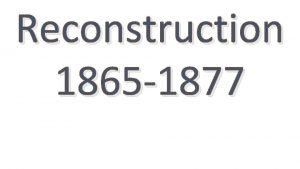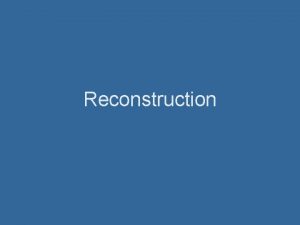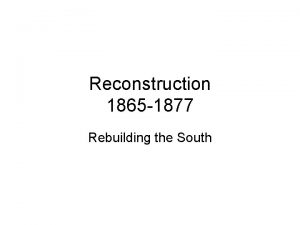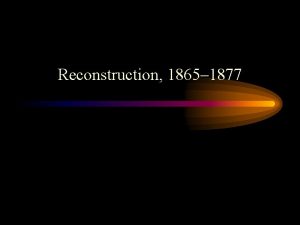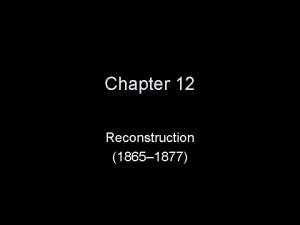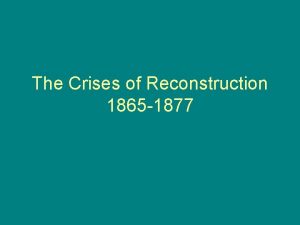Reconstruction 1865 1877 Reconstruction in United States history

















































- Slides: 49

Reconstruction: 1865 -1877

Reconstruction • in United States history, Reconstruction was the process of rebuilding that followed the American Civil War(1861 -1865). • Why the need for Reconstruction? what needed to be rebuilt? – – – Human Lives (death and wounded) Physical destruction Economically Constitutionally Socially Psychologically

Why the need for Reconstruction? what needed to be rebuilt? • Military Casualties 360, 000 Union soldiers dead 260, 000 Confederate soldiers dead 620, 000 Total dead 375, 000 Seriously wounded and maimed for life 995, 000 Casualties nationwide in a total male population of 15 million (1 in 15) • Physical and Economic Crisis – Destruction of Southern Railroads, Industry, Livestock, Fields

Why the need for Reconstruction? what needed to be rebuilt? • Constitutional Crisis – Eleven ex-confederate states not a part of the Union Status unclear (how to bring them back into the Union) • Social Crisis – Nearly 4 million black freedmen face challenges of survival and freedom – Thousands of hungry, displaced former confederate soldiers and other southern whites

Why the need for Reconstruction? what needed to be rebuilt? • Psychological Crisis – Resentment, bitterness, anger, and despair throughout the North and the South • Since the United States had never before experienced civil war, the end of hostilities left Americans to grapple with a set of pressing questions over what to do with the South after the defeat of the Confederacy and the overthrow of slavery.

Pressing Questions over What to do with the South • These questions included: • 1) What was the relationship between the former Confederate states and the federal Union? What should be demanded of those states before they were regarded as reconstructed? • 2) Who was responsible for the Confederate rebellion? Who, if anyone, should be punished for it?

Pressing Questions over What to do with the South • 3) What should be the position of the newly-freed slaves? What responsibility did the government have to extend basic rights to them? Which rights? • 4) How should the Southern economy be converted from one based on slave labor to one based on free labor?

Presidential Plans for Reconstruction • Lincoln’s Plan – All southern white males, except high Confederate officials , could regain full rights as US citizens by taking a simple oath pledging their loyalty to the Union. – When 10 percent of a Confederate state’s voters took the oath, the state could form a new government and adopt a new constitution. ( the constitution had to prohibit slavery)

Problems with Lincoln’s Plan: • Many Northerners believed that Lincoln’s plan was too mild because it did not hold the South responsible for causing the Civil War. • Before Lincoln could put his plan into effect, he was assassinated by John Wilkes Booth at Ford’s Theatre in Washington, D. C.

Presidential Plans for Reconstruction • Johnson’s Plan – After taking over as President, Johnson proposed to carry out Lincoln’s ideas – Re-entry into the Union with 10 percent of citizens of the state (excluding former Confederate officials, officers, and plantation owners). • Johnson distrusted the aristocratic (upper class) southern society. • Johnson didn’t believe blacks were equal to whites.

Presidential Plans for Reconstruction – By the fall of 1865, new state governments had been organized throughout the South. – Steps were taken to help former slaves • Congress proposes 13 th Amendment – this amendment called for the abolition of slavery in all parts of the country – This amendment went into effect following ratification by 2/3 House, 2/3 Senate, 3/4 State Legislatures.

Johnson’s Plan • Steps were taken to help former slaves – Congress organized the Freedmen’s Bureau which helped blacks find jobs, protected their rights, and established hospitals and schools for them throughout the South.

Southern whites tried to limit the freedoms of ex-slaves. • The newly formed white controlled state governments in the south passed laws called “Black Codes” • One of these codes required blacks to sign contracts forcing them to work at a job for a full year. • Another allowed white employers to whip black workers • Other codes limited freedom of speech and travel, denied the right to vote, allowed states to put unemployed blacks in jail, and prevented blacks from testifying against whites in court.

Southern whites tried to limit the freedoms of ex-slaves • Congress passed the 1866 Civil Rights Act which formally gave citizenship to blacks and forbade states from passing discriminatory laws against African. Americans. – Johnson vetoed the 1866 Civil Rights Act. – Congress began to look for a way to impeach Johnson.

Radical Republicans gain Control of Reconstruction • Republicans gained 2/3 majority of Congress. – Override of Presidential Veto – Power was in the hands of the Legislature • Republicans believed that the South should be penalized for causing the war. – Republican reconstruction plan would be harsh on the South


Reconstruction governments were opposed by Southern whites • Three groups in the South combined to give the Republican Party control of all the Southern State governments. – 1. The blacks formed the largest group of Southern Republicans – 2. “Carpetbaggers” were Northerners who came south seeking economic and political opportunities. • A. Many bought cotton lands or opened businesses • b. Sixty carpetbaggers were elected to Congress and nine became governors. – 3. “Scalawags” were Southern whites who had either opposed secession or who now believed that it was best to cooperate with the North

Reconstruction governments were opposed by Southern whites • Ulysses S. Grant, who served as President from 1869 to 1877, supported Congress’ tough Reconstruction policies. – The Republican-controlled state governments achieved numerous successes. • 1. Tax-supported public school systems were set up • 2. Money was given to develop railroads and various industries • 3. Blacks were given the opportunity to hold political office • 4. Racial discrimination was outlawed (but not enforced)

Reconstruction governments were opposed by Southern whites • Most Southern whites refused to support the Reconstruction governments. – 1. They complained that the 14 th Amendment kept many Southern leaders from holding political office. – 2. A number of whites had their land property taken away because they could not pay taxes.

Reconstruction governments were opposed by Southern whites – 3. Many carpetbaggers and scalawags in the Reconstruction governments accepted money in exchange for political favors. – 4. The majority of Southern whites could not accept the idea of former slaves voting and holding office. – 5. Many whites attacked blacks and their white supporters.

Reconstruction governments were opposed by Southern whites Reconstruction came to an end when the Republican Party lost its power in the Southern states. – 1. The Southern Democrats defeated the Republicans and took control of most state governments between 1869 and 1876. • A. The use of violence kept large numbers of blacks away from the polls, thereby helping the Democrats to victory. • B. Federal troops that were backing the Republicancontrolled governments were gradually withdrawn because many Northerners were losing interest in Reconstruction.

Reconstruction governments were opposed by Southern whites • 2. The Reconstruction Period came to a close when President Rutherford B. Hayes ordered the last federal troops out of the South in 1877. – As the Democrats gained power in the South, they gained the power to demand concessions • Hayes-Tilden election of 1876 closest (Tilden wins popular vote) – Hayes makes a deal with Southern Democrats (Compromise of 1877) in exchange for victory—he pulled out Federal Troops from South—thus abandoning the Blacks and Reconstruction- for their votes.

Reconstruction had both positive and negative effects on the South. • Several major achievements were realized – 1. The states that had seceded were restored to the Union and the rebuilding of the South was begun. – 2. Public school systems were established (good for whites, poor for blacks) – 3. The 14 th and 15 th Amendments, though often violated by Southern whites, eventually became the basis of the Civil Rights movement which began in the 1950’s and helped blacks in their struggle for equality.

Fourteenth Amendment – Designed to stop the discriminatory practices of Southern whites against blacks (Black Codes) – Gave blacks, “equal protection of the law” where no state could deprive any person of life, liberty, or property without “due process of law. ” – These were basic rights that all citizens were granted under the Constitution, therefore blacks were now regarded as citizens of the United States under the 14 th Amendment.

Fifteenth Amendment – Despite the fact that blacks were given citizenship, they were being denied the right to vote through legal, though unfair, practices • Grandfather clauses, poll taxes, and literacy tests were designed to keep blacks from voting – In response to these unfair practices, Congress drafted the 15 th Amendment which gives all citizens the right to vote regardless of circumstances other than felony offences.

Reconstruction had both positive and negative effects on the South • Reconstruction failed to solve the problems of the blacks and the South as a whole. – 1. The majority of former slaves could not afford their own land, and continued to work for the cotton planters (sharecropping—another form of slavery). – 2. The South was slow to expand its economy, and long remained the poorest section of the country.

Reconstruction had both positive and negative effects on the South – 3. The whites held political power and the blacks eventually lost all of the rights they had gained under the Republicans. • A. Large numbers of blacks were prevented from voting because they could not afford to pay “poll taxes. ” • b. Other blacks were kept from voting because of “grandfather clauses” which said that people whose ancestors could not vote on January 1, 1867, could not vote either; no blacks had been able to vote on that date. • C. The passage of “Jim Crow Laws” kept the races apart, or segregated, ” in housing, transportation facilities, public accommodations, and schools.

Reconstruction had both positive and negative effects on the South • Because the Reconstruction had been carried out by the Republican Party, white southerners overwhelmingly voted for Democratic candidates, thus creating the “Solid South” • White supremacy groups formed, hate crimes/lynchings

Reconstruction Questions • 1. How did Lincoln’s plan for Reconstruction reflect his personal feelings? – His plan was mild and forgiving. It reflected that the South should not suffer more hardships. • 2. In general, how did the Radical’s initial plan for Reconstruction differ from Lincoln’s? – The Radical plan sought revenge and pain on the South.

Reconstruction Questions • 3. Why was Johnson’s approach to Reconstruction a surprise to both white Southerners, and to the Radicals? – Both expected his support for Radical Reconstruction. He supported Lincoln’s plan instead.

• 4. What were the main accomplichments of the Freedmen’s Bureau? – The Freedmen’s Bureau supplied food and clothing, set up schools, hospitals, teacher training, and industrial institutes to aid former slaves and needy whites. • 5. How did black codes affect the lives of the slaves? – Black codes limited the rights and mobility of the former slaves.

• 6. Why did Congress feel that there was a need for the Fourteenth Amendment? – Unlike the Civil Rights Act, a Constitutional amendment could not be vetoed by the President. • 7. How did Congress enforce the First Reconstruction Act? – It used military administrators and federal troops.

• 8. What events led to President Johnson’s impeachment? – Johnson vetoed important legislation, refused to enforce the Reconstruction Act, publicly attacked Congress, and refused to abide by the Tenure of Office Act. • 9. How was the impeachment of Andrew Johnson a threat to the American system of Checks and Balances? – Congress tried to make the President directly answerable to them rather than independent and separate in powers and duties.

• 10. How did the Fifteenth Amendment affect the North as well as the South? – In both the North and the South, it guaranteed the right to vote to all males, including blacks formerly barred from voting. • 11. Why did sharecropping and tenant farming prove to be unsatisfactory land arrangements? – After paying off landowners, blacks seldom could save enough money to buy land.

• 12. What was the reality behind the charges that Reconstruction excluded Southern whites from voting and that it allowed illiterate blacks to vote? – Race was the reality behind the charges. During Reconstruction, white voter registration was almost as before the Civil War. Illiterate blacks were allowed to vote, but literacy had never been a requirement for voting.

• 13. What were the motives of the people from the North and the South who supported Reconstruction? – Some scalawags and carpetbaggers were selfish, greedy, and scheming. Others in both groups wanted to help the South and the blacks. • 14. What were some of Reconstruction’s positive effects on poor whites? – They could vote for the first time, attend newly established public schools, and not be imprisoned for debt.

• 15. How did Congress attempt to protect black people from racist secret societies? – Federal election laws and federal troops were attempts made to protect the blacks. (failed) • 16. What were the main reasons why Northern support for Radical reconstruction lessened in the late 1870 s? – Northerners tired of the problems it casued; its leaders had died; business interests wanted stability in the South; and the Republican Party no longer needed the black vote.

• 17. What were the main problems that plagued Grant’s second term as President? – Widespread corruption and economic depression were troubles that faced Grant’s administration. • 18. What were the main elements of the deal that gave the 1876 Presidential election to Hayes? – The deal brought removal of federal troops from the South, more federal money for the South’s transportation facilities, and the appointment of a Southern cabinet member.

• 19. How was voting by Black people restricted? – Black voting was restricted through poll taxes, literacy tests, and grandfather clauses. These laws seemed to apply to everyone, but actually excluded blacks only. • 20. How was legal segregation of public facilities accomplished? – Southern legislatures passed laws allowing separate facilities. The Supreme Court confirmed them as long as the facilities were equal (Plessy v. Fergusson).

Reconstruction Terms

1. Reconstruction Act of 1867 – – Divided all of the seceded states into five military districts (20, 000 troops sent to enforce) Placed each district under the command of a major general who was to oversee the creation of new constitutions for each state • – – Constitutions were required to give black males the right to vote and ratify (accept as law) the 13 th Amendment Johnson vetoed (Congress overrode his veto) Southern whites regarded as extremely harsh and unfair: did not regard blacks as equal to whites

2. Tenure of Office Act – Johnson tried to stop Radical Reconstruction by placing officials sympathetic to the South in key positions (generals). This angered Congress who looked for a way to impeach Johnson – Congress passed the Tenure of Office Act which stopped the President from firing cabinet officials without the consent of Congress – Johnson fired Edwin Stanton, Secretary of War – The House of Representatives impeached Johnson for violation of the law, but the Senate narrowly allowed Johnson to stay (with little power)

8. Jim Crow Laws – Laws passed in the South which created separate facilities for whites and blacks • “Jim Crow” was a phrase that referred to African Americans

10. Disenfranchised – When a person loses their right to vote, or are effectively denied basic citizenship privileges • Blacks were disenfranchised following the imposition of Black Codes, Jim Crow Laws as well as Literacy tests, Poll Taxes, and Grandfather clauses.

11. Separate But Equal – Phrase used by Southern racists trying to show that they weren’t abusing the 14 th Amendment rights of African Americans by providing them separate facilities such as schools, hospitals, transportation, and others. • White facilities were given more attention and money, thus were better than black facilities. This meant that the facilities were separate, but unequal (a violation of the 14 th Amendment of equal protection)

12. Compromise of 1877 – An agreement between Rutherford B. Hayes and Southern election officials who agreed to give him enough votes to win the election of 1876, in return for removing the remaining Federal Troops. • By removing the troops, there was little or no protection for Southern Blacks • Reconstruction was now over, the North gave up.

13. Poll Taxes – A fee which had to be paid by anyone who wanted to vote • This excluded many blacks who did not have the money to vote • This was an attempt by the white population to reduce the power of the Republicans and the blacks

14. Literacy Tests – A test given to anyone wanting to vote. If you could read, you could vote • Another attempt by Southern whites to control blacks and reduce the power of the Republicans in the South – Many blacks were illiterate at the time

15. Grandfather Clauses – A law which said that if you had relatives who voted prior to 1861, you could vote again. • Excluded blacks who didn’t have relatives who voted prior to 1861
 Whats the compromise of 1877
Whats the compromise of 1877 Bourbon triumvirate definition
Bourbon triumvirate definition Us history regents essay
Us history regents essay Joseph pulitzer apush
Joseph pulitzer apush Period 5 key concepts apush
Period 5 key concepts apush Compromise of 1877
Compromise of 1877 Gilded age strikes
Gilded age strikes Whats the compromise of 1877
Whats the compromise of 1877 1877 golden 1
1877 golden 1 Tanssija 1877-1927
Tanssija 1877-1927 Define compromise of 1877
Define compromise of 1877 The gilded age 1877 to 1898 worksheet answers
The gilded age 1877 to 1898 worksheet answers Great railroad strike of 1877 significance
Great railroad strike of 1877 significance The key tradeoff featured in the compromise of 1877
The key tradeoff featured in the compromise of 1877 Urban america 1865 to 1896
Urban america 1865 to 1896 Hollywood silver fox farm v emmett
Hollywood silver fox farm v emmett The rise of industrial america 1865-1900
The rise of industrial america 1865-1900 Four features of industrial manufacturing (1865-1900)
Four features of industrial manufacturing (1865-1900) 15 th ammendment
15 th ammendment Industrialization 1865 to 1901
Industrialization 1865 to 1901 Becoming a world power 1865-1917
Becoming a world power 1865-1917 Monet
Monet Chapter 20 becoming a world power notes
Chapter 20 becoming a world power notes Settling the west 1865-1890
Settling the west 1865-1890 Gregor mendel 1865
Gregor mendel 1865 How did renoir glamorize his clientele
How did renoir glamorize his clientele Regionalism literature
Regionalism literature Industrialization (1865 to 1901 worksheet answers key)
Industrialization (1865 to 1901 worksheet answers key) 1865 to 1900 inventions
1865 to 1900 inventions Was the united states on the axis powers or allied powers?
Was the united states on the axis powers or allied powers? Mediterranean climate in us
Mediterranean climate in us 36 30 line
36 30 line Pro soccer us
Pro soccer us United states v nixon outcome
United states v nixon outcome United states student association
United states student association The united states ought to provide a universal basic income
The united states ought to provide a universal basic income Preamble of us constitution
Preamble of us constitution The united states in the caribbean 1776 to 1985
The united states in the caribbean 1776 to 1985 Southeast region physical features
Southeast region physical features Expansion of the united states of america 1607 to 1853 map
Expansion of the united states of america 1607 to 1853 map Who was nicholas novikov? when did he write this telegram?
Who was nicholas novikov? when did he write this telegram? Who was the previous owner of the spanish cession
Who was the previous owner of the spanish cession Awake united states song
Awake united states song Mapp v ohio
Mapp v ohio Why did the united states invade cuba in 1898?
Why did the united states invade cuba in 1898? Chapter 6 lesson 2
Chapter 6 lesson 2 Midwest region of the united states
Midwest region of the united states 7 regions of the united states
7 regions of the united states The united states is the greatest buyer positive degree
The united states is the greatest buyer positive degree United states and canada physical map
United states and canada physical map
